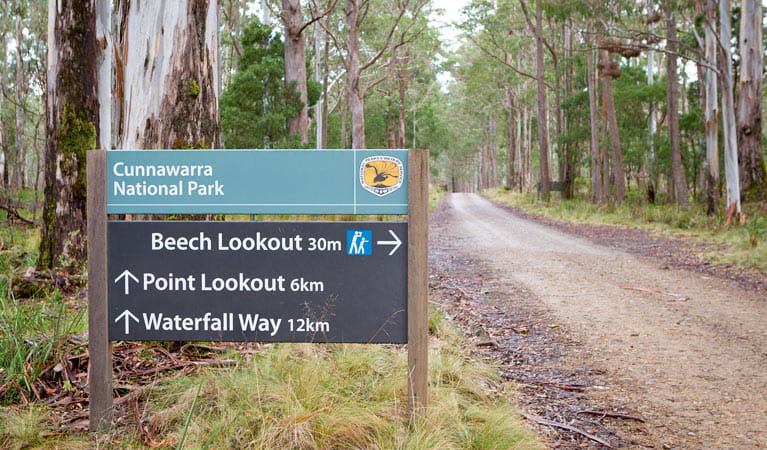Beech lookout
Cunnawarra National Park
Overview
Head to Beech lookout in Cunnawarra National Park for remarkable views out over World Heritage-listed rainforest.
- Type
- Lookouts
- Where
- Cunnawarra National Park in North Coast, Country NSW
- Accessibility
- Medium
- What to
bring - Drinking water
- Please note
- The weather in this area can be extreme and unpredictable, so please ensure you’re well-prepared for your visit.
- There is limited/no mobile reception in this park
- Remember to take your binoculars if you want to go birdwatching
Beech lookout is an absolute must-see spot if you’re visiting Cunnawarra National Park. Here, you can enjoy spectacular views out across the headwaters of Georges River south to Cunnawarra Range, Botumburra Range and beyond into the Macleay River valley.
Just below the lookout are some of NSW’s tallest trees. These majestic forest ribbon gums reach an impressive 70m in height and can grow as wide as 3m in diameter. From here, you can also spot the lush green crowns of ancient Antarctic beech trees.
Keep your eyes out for the many threatened species that call the area home. If you’re lucky, you may even spot a powerful owl or glossy black cockatoo in the trees below, or a wedge-tailed eagle soaring across the skies above.
Map

Map legend

Local alerts
For the latest updates on fires, closures and other alerts in this area, see https://www.nationalparks.nsw.gov.au/things-to-do/lookouts/beech-lookout/local-alerts
General enquiries
- National Parks Contact Centre
- 7am to 7pm daily
- 1300 072 757 (13000 PARKS) for the cost of a local call within Australia excluding mobiles
- parks.info@environment.nsw.gov.au
Park info
- in Cunnawarra National Park in the North Coast and Country NSW regions
Cunnawarra National Park is always open, but may have to close at times due to poor weather or fire danger.
Visitor info
All the practical information you need to know about Beech lookout.
Getting there and parking
Beech lookout is in Cunnawarra National Park. To get there:
From Dorrigo:
- Travel west along Waterfall Way towards Ebor/Armidale
- Turn left to follow Waterfall Way towards Ebor/Armidale
- Continue to Ebor
From Ebor:
- Travel west along Waterfall Way towards Armidale
- Turn left to stay on Waterfall Way towards Armidale
- After about 7.6km, turn left onto Point Lookout Road.
- Continue onto Styx Forest Way
From Armidale:
- Travel east along Waterfall Way for approximately 65km
- Turn right onto Armidale Kempsey Road just past Wollomombi
- After about 20km turn left onto Styx Forest Way
Road quality
Check the weather before you set out as the road to Beech lookout can become boggy when it rains.
- Unsealed roads
Vehicle access
- All roads require 4WD vehicle
Weather restrictions
- 4WD required in wet weather
Parking
Parking is available at Beech lookout along unsealed, gravel Forest Way.
Best times to visit
There are lots of great things waiting for you in Cunnawarra National Park. Here are some of the highlights.
Autumn
Enjoy the many splendours of the park from the comfort and warmth of your 4WD along Styx Forest Way. Don't miss the easily accessible scenic detour off Waterfall Way.
Spring
Head to Beech lookout on Styx Forest Way to gaze out over ancient Antarctic beech rainforest, including some of the tallest trees in NSW.
Summer
Go birdwatching in the park, keeping your eyes out for threatened species such as powerful owls, rufous scrub-birds and glossy black cockatoos.
Weather, temperature and rainfall
Summer temperature
Average
13°C and 24°C
Highest recorded
32.8°C
Winter temperature
Average
1°C and 13°C
Lowest recorded
-7°C
Rainfall
Wettest month
January
Driest month
June
The area’s highest recorded rainfall in one day
84mm
Facilities
- You'll need to bring your own drinking and cooking water
- You’re encouraged to bring gas or fuel stoves, especially in summer during the fire season.
Barbecue facilities
- Wood barbecues (bring your own firewood)
Carpark
Step-free access
The lookout is mostly flat and step-free, but there are no pathways. You'll need to cross over hard-packed ground to reach the lookout railing.
There may be trip hazards between the parking area and the lookout railing, such as sticks, tufted grass and uneven ground.
Maps and downloads
Accessibility
Disability access level - medium
Beech lookout is mostly flat and step-free, but there are no pathways.
From the parking area on unsealed gravel Forest Way, you'll need to cross over hard-packed ground to reach the lookout railing. There may be trip hazards along the ground including sticks and tufted grass.
Prohibited
Gathering firewood
Pets
Pets and domestic animals (other than certified assistance animals) are not permitted. Find out which regional parks allow dog walking and see the pets in parks policy for more information.
Smoking
NSW national parks are no smoking areas.
Learn more
Beech lookout is in Cunnawarra National Park. Here are just some of the reasons why this park is special:
Diverse wildlife

Not only is Cunnawarra home to some of the most impressive trees in NSW, it’s also home to an incredible diversity of wildlife. Among the wildlife you’re likely to spot here is a number of threatened species, including powerful owls, spotted-tailed quolls, rufous scrub-birds and glossy black cockatoos.
- Beech lookout Head to Beech lookout in Cunnawarra National Park for remarkable views out over World Heritage-listed rainforest.
Explore World Heritage-listed rainforest

Cunnawarra is part of the New England Group of Gondwana Rainforests of Australia World Heritage Area, and was added to the Australian National Heritage List in 2007. It features some remarkable examples of subtropical, warm temperate and Antarctic beech cool temperate rainforest, making it an absolute haven for nature-lovers
The tallest trees in NSW

Cunnawarra boasts significant areas of old-growth forest, including large swathes of well-developed moist eucalypt trees. Perhaps one of the most imposing, though, is a stand of forest ribbon gum that contains some of the tallest recorded trees in NSW.
- Beech lookout Head to Beech lookout in Cunnawarra National Park for remarkable views out over World Heritage-listed rainforest.

